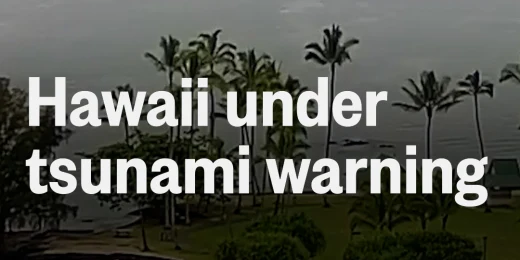tsunami in Russia today, The world woke up today to shocking news: an 8.8-magnitude earthquake struck off Russia’s far eastern coast, triggering tsunami alerts across the Pacific region. The tremor has not only rattled Russia but also set Hawaii, Alaska, and the entire U.S. West Coast—including California, Washington, and Oregon—on high alert.
As the situation unfolds, one question looms large: how soon will the tsunami waves hit, and what should people do to stay safe? Here’s everything you need to know about tsunami in Russia today, its potential impact, and the estimated timings for the U.S. coastal regions.
The Earthquake That Sparked the Pacific-Wide Tsunami Alert
The day started with seismic chaos. A powerful 8.8-magnitude earthquake struck near Russia’s Kamchatka Peninsula, one of the most seismically active regions on the planet. The quake immediately prompted tsunami warnings, and the shockwaves are now being felt across the Pacific Ocean.
This isn’t just another headline-grabbing natural event. An earthquake of this size can displace massive volumes of water, generating waves that travel thousands of miles at jet-like speeds. That’s exactly why coastal cities in Alaska, Hawaii, Washington, Oregon, and California are on high alert.
Alaska Feels the First Impact
Whenever a major earthquake occurs in the North Pacific, Alaska is often the first U.S. state in the tsunami’s path. And this time was no different.
Residents of Alaska’s western Aleutian Islands, Kodiak, and Southeast Alaska have already witnessed the first tsunami waves. While the waves have not yet caused catastrophic destruction, emergency teams are on the ground, ready to respond if the situation worsens.
Hawaii: Bracing for Bigger Waves
Hawaii, sitting directly in the tsunami’s path, has already experienced waves as high as four feet slamming into its shores.
For now, there are no confirmed reports of property damage, but the Hawaii Emergency Management Agency (EMA) isn’t taking any chances. Emergency shelters in Hawaii County have been opened, and authorities are urging residents to stay away from the beaches.
“So far, so good. There is no plan to shut off power in advance. Don’t get on the road at all tonight. Airports haven’t been impacted yet, but all flights in and out of Hawaii have been cancelled for tonight,” said a Hawaii EMA spokesperson.
In other words, even if things seem calm for now, Hawaii is preparing for what could be a long and dangerous night.
Estimated Tsunami Timings for the U.S. West Coast
The National Tsunami Warning Center has shared a timeline for when waves from the tsunami in Russia today could reach different parts of the U.S. coast. These times are only estimates, but they offer a critical heads-up for residents and emergency services:
-
Washington & Oregon: Between 2:35 am – 2:55 am ET (12:05 pm – 12:25 pm IST)
-
Northern California: Around 2:50 am ET (12:20 pm IST)
-
San Francisco Bay Area: Around 3:40 am ET (1:10 pm IST)
-
Southern California: Around 4 am ET (1:30 pm IST)
Authorities are warning that these waves won’t come alone. Tsunamis often arrive in a series of multiple waves, and sometimes the most destructive wave isn’t the first.
Why California Is on High Alert
California is no stranger to earthquake-related tsunami threats. The National Weather Service (NWS) has issued a tsunami advisory for the Bay Area and Central Coast, including San Francisco and San Pablo Bays.
Officials have specifically warned residents to stay away from:
-
Beaches
-
Harbors
-
Marinas
-
Coastal waterways
The NWS has also cautioned that dangerous currents and unpredictable waves are expected, even in places that may not experience dramatic flooding.
Los Angeles and Southern California Prepare for Impact
Further south, the Los Angeles branch of the NWS has echoed similar warnings. Rising water levels and unusually strong currents could affect every beach area, harbor, and marina in Southern California.
“Tsunamis typically arrive as a series of waves, which can be dangerous for many hours after the first wave,” officials stated.
In other words, if you’re anywhere near the Southern California coastline, this isn’t the time to go wave-watching. Authorities strongly advise staying inland and monitoring official updates.
The Role of the Indian Mission in San Francisco
Interestingly, the Indian mission in San Francisco has also issued guidance for the large Indian community across the U.S. West Coast. Their advice?
-
Stay away from beaches and coastal areas.
-
Move to higher ground if a tsunami warning is issued.
-
Follow all local alerts without delay.
-
Prepare emergency supplies, including food, water, and essential documents.
This advisory isn’t just for Indian nationals—it’s practical advice for everyone living in potential impact zones.
The Science Behind a Tsunami in Russia Today
Let’s break this down. A tsunami isn’t just a “big wave.” When a powerful undersea earthquake like the one off Russia’s coast strikes, it causes a sudden shift in the ocean floor.
Think of it as shaking a bowl of water—the liquid sloshes back and forth. Only in this case, we’re talking about an entire ocean. This movement sends shockwaves racing across the Pacific, eventually hitting coastlines thousands of miles away.
What Makes This Event Different
While smaller tsunamis happen from time to time, the scale of the tsunami in Russia today has global significance. The quake’s 8.8 magnitude puts it in the “mega-quake” category—capable of creating destructive waves not only in Russia but also in Alaska, Hawaii, and the U.S. mainland.
The Pacific region has not seen a quake this powerful in years, and emergency agencies are treating it as a worst-case scenario until proven otherwise.
How Long Will the Tsunami Threat Last?
Here’s the tricky part: tsunamis don’t come and go quickly. According to the National Tsunami Warning Center, waves may continue for several hours. And because the first wave isn’t always the strongest, coastal residents must remain on alert until officials give the all-clear.
In short, if you’re in any advisory area, don’t assume you’re safe just because the first wave wasn’t catastrophic. Tsunamis can be unpredictable.
What You Should Do Right Now
If you’re in California, Washington, or Oregon—or even Hawaii—take these steps immediately:
-
Stay Informed: Follow the National Weather Service and local emergency alerts.
-
Avoid the Coast: Even if the waves don’t look threatening, stay away from beaches and marinas.
-
Move to Higher Ground: If you live in a low-lying area, evacuate if advised.
-
Prepare Essentials: Keep emergency supplies ready—water, food, batteries, and first-aid kits.
-
Listen to Officials: Don’t return to coastal areas until you’re told it’s safe.
Final Thoughts: Stay Alert, Stay Safe
The tsunami in Russia today is a stark reminder of how interconnected the world’s oceans are. A single earthquake can send shockwaves—literally—across continents.
For now, all eyes are on the Pacific Coast. Authorities in Hawaii, Alaska, Washington, Oregon, and California are doing everything possible to protect lives. But ultimately, personal safety depends on how quickly people respond to warnings.
When nature shows its power, the best defense is caution. Stay alert, stay informed, and above all—stay safe.
Read More: Tata Motors Share Price Cracks Over 3% on Iveco Acquisition Buzz – Should You Be Worried?
Conclusion
From the powerful quake near Russia to the tsunami warnings along the U.S. West Coast, this is a developing story that demands attention. While we still don’t know the full impact, the timeline for wave arrivals is clear—and so are the safety instructions.
This is one of those moments when preparation is everything. The Pacific is restless, but with the right actions, we can stay ahead of the danger.









